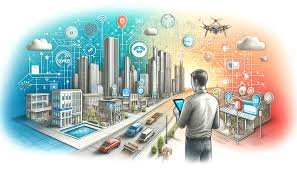The Role of AI and Machine Learning in Shaping Future Smart Cities
As urbanization accelerates globally, cities face numerous challenges, from traffic congestion to resource management. Artificial Intelligence (AI) and Machine Learning (ML) are pivotal in transforming traditional urban environments into smart cities that enhance the quality of life for residents while optimizing city services. This transformation is characterized by the integration of technology into urban planning, infrastructure, and public services, enabling data-driven decision-making and improved efficiency.
Enhancing Urban Mobility
AI and ML are revolutionizing urban mobility through intelligent transportation systems. By analyzing real-time data from traffic sensors, cameras, and GPS devices, these technologies can optimize traffic flow, reduce congestion, and improve public transportation scheduling. Predictive analytics can forecast peak traffic times and suggest alternative routes, minimizing delays and enhancing the overall commuting experience.
Efficient Resource Management
In smart cities, AI and ML facilitate better resource management, particularly in energy and water distribution. Smart grids utilize AI algorithms to predict energy demand and optimize supply, ensuring efficiency and sustainability. Similarly, AI-driven systems can monitor water usage patterns, detect leaks, and improve conservation efforts, helping cities manage their resources more effectively.
Public Safety and Security
AI-powered surveillance systems enhance public safety by providing real-time monitoring and threat detection. Machine learning algorithms can analyze video feeds to identify suspicious activities and alert law enforcement. Furthermore, predictive policing models can help allocate police resources more effectively by analyzing crime patterns and trends.
Environmental Sustainability
AI and ML contribute significantly to environmental sustainability in smart cities. By monitoring air quality, noise levels, and other environmental factors, cities can implement measures to mitigate pollution and improve residents' well-being. Machine learning models can also optimize waste management systems, predicting waste generation patterns and enhancing recycling efforts.
Citizen Engagement and Participation
Smart cities leverage AI to foster citizen engagement through personalized services and communication. Chatbots and virtual assistants can provide residents with information on city services, events, and emergency alerts, ensuring a more connected community. Additionally, AI-driven platforms can gather citizen feedback, enabling governments to make data-informed decisions that reflect the needs and preferences of their constituents.
Conclusion
The integration of AI and machine learning in shaping future smart cities holds immense potential for addressing urban challenges. By enhancing mobility, resource management, public safety, environmental sustainability, and citizen engagement, these technologies pave the way for more efficient, livable, and resilient urban environments. As cities continue to evolve, the role of AI and ML will be crucial in fostering innovation and improving the overall quality of life for urban residents.











